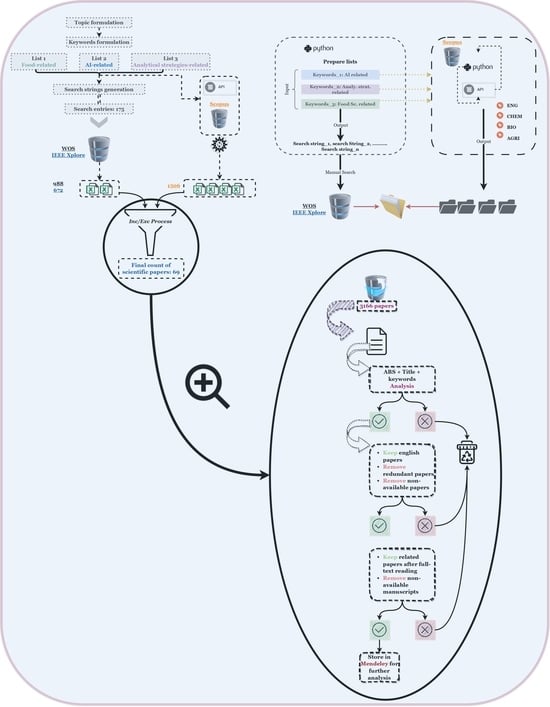Combining AI Tools with Non-Destructive Technologies for Crop-Based Food Safety: A Comprehensive Review
Abstract
:1. Introduction
2. Background
2.1. Spectroscopy for Food Safety and Quality
2.2. Integrating AI Tools for Food Safety and Quality Analysis
3. Methodology
3.1. Topic Formulation
- What are the analytical strategies that are mainly used for crop-food safety and which techniques were dominantly incorporated?
- What are the AI-based tools that were embodied to ensure crop-food safety?
- Did these AI-based systems prove to be beneficial in research and industry? To what degree they proved to be explainable or/and interpretable?
3.2. Study Design
3.2.1. WOS and IEEE Xplore Data Collection
- Food: food, foodborne, crop, cereal, and toxin.
- Analytical Strategies: analytical strategies, biochemistry, chemical analysis, spectroscopy, omics, immunosensor, and biosensor.
- AI tools: artificial intelligence, machine learning, deep learning, neural networks, and computer vision.
3.2.2. Scopus Data Collection
3.2.3. Inclusion and Exclusion Process
- Inc/Exc 1: A first selection based on the relevance of these papers to the topic, after thoroughly reading the title, key words, and abstract sections, respectively. The number of papers included were 30, 166, and 242 for IEEE Xplore, WOS, and Scopus databases, respectively.
- Inc/Exc 2: A further evaluation of these collected papers was conducted based on their original language and availability online, also removing duplicates, which ended with a total of 109 papers included.
- Inc/Exc 3: A full reading process was thoroughly executed to decide which of these papers are the most relevant to our topic of research, leaving 69 papers.
4. Data Description and Analysis
4.1. Quantitative Analysis
4.2. Qualitative Analysis
4.3. Review Papers
4.3.1. Analytical Strategies and AI as Nondestructive Tools for Crop-Food Safety
4.3.2. Interdisciplinary Approaches in Crop-Food Safety
4.3.3. Analytical Strategies and Recent Technologies for Food Safety
4.4. Article Papers
4.4.1. Raman Spectroscopy
4.4.2. Visible and Near-Infrared Spectroscopy
4.4.3. Time-Domain Spectroscopy (THz–TDS)
4.4.4. Fluorescence Spectroscopy
4.4.5. Nuclear Magnetic Resonance (NMR)
4.4.6. Hyperspectral Imaging
4.4.7. Comparative Studies
4.4.8. Electroanalytical Methods
5. Research Gaps and Challenges
- The complexity and diversity of food matrices, which may require different AI models and parameters for different food products and contaminants.
- The lack of standardization and validation of AI methods and data, which may affect the accuracy, reliability, and comparability of the results.
- The potential risks and uncertainties of AI applications in agriculture, such as environmental impacts, socioeconomic impacts, cyber-attacks, biases, and errors, which may affect food security, sustainability, and resilience.
- The need for interdisciplinary collaboration and stakeholder engagement, which may involve challenges such as communication barriers, knowledge gaps, cultural differences, and conflicting interests.
5.1. Big Data
5.2. Learning Methods, XAI, and Interpretability
5.3. Real-World Applications
6. Conclusions and Future Work
Author Contributions
Funding
Institutional Review Board Statement
Informed Consent Statement
Data Availability Statement
Acknowledgments
Conflicts of Interest
References
- Garcia, S.N.; Osburn, B.I.; Jay-Russell, M.T. One health for food safety, food security, and sustainable food production. Front. Sustain. Food Syst. 2020, 4, 1. [Google Scholar] [CrossRef]
- Hargreaves, S.M.; Rosenfeld, D.L.; Moreira, A.V.B.; Zandonadi, R.P. Plant-based and vegetarian diets: An overview and definition of these dietary patterns. Eur. J. Nutr. 2023, 62, 1109–1121. [Google Scholar] [CrossRef]
- Matthews, P.J.; Ghanem, M.E. Perception gaps that may explain the status of taro (Colocasia esculenta) as an “orphan crop”. Plants People Planet 2021, 3, 99–112. [Google Scholar] [CrossRef]
- Neufeld, L.M.; Hendriks, S.; Hugas, M. Healthy Diet: A Definition for the United Nations Food Systems Summit 2021. In A Paper from the Scientific Group of the UN Food Systems Summit; Springer International Publishing: Cham, Switzerland, 2021. [Google Scholar]
- FAO. Thinking about the Future of Food Safety—A Foresight Report; FAO: Rome, Italy, 2022. [Google Scholar] [CrossRef]
- Mohanty, S.P.; Hughes, D.P.; Salathé, M. Using deep learning for image-based plant disease detection. Front. Plant Sci. 2016, 7, 1419. [Google Scholar] [CrossRef]
- Raki, H.; González-Vergara, J.; Aalaila, Y.; Elhamdi, M.; Bamansour, S.; Guachi-Guachi, L.; Peluffo-Ordoñez, D.H. Crop Classification Using Deep Learning: A Quick Comparative Study of Modern Approaches. In Proceedings of the International Conference on Applied Informatics, Serdang, Malaysia, 18–19 May 2022; Springer: Cham, Switzerland, 2022; pp. 31–44. [Google Scholar]
- Kamala, K.; Kumar, V.P. Food products and food contamination. In Microbial Contamination and Food Degradation; Elsevier: Amsterdam, The Netherlands, 2018; pp. 1–19. [Google Scholar]
- Bintsis, T. Microbial pollution and food safety. AIMS Microbiol. 2018, 4, 377. [Google Scholar] [CrossRef]
- Turek, C.; Stintzing, F.C. Stability of essential oils: A review. Compr. Rev. Food Sci. Food Saf. 2013, 12, 40–53. [Google Scholar] [CrossRef]
- Clapp, J.; Moseley, W.G.; Burlingame, B.; Termine, P. The case for a six-dimensional food security framework. Food Policy 2021, 106, 102164. [Google Scholar] [CrossRef]
- Chatterjee, A.; Abraham, J. Microbial contamination, prevention, and early detection in food industry. In Microbial Contamination and Food Degradation; Elsevier: Amsterdam, The Netherlands, 2018; pp. 21–47. [Google Scholar]
- Chitrakar, B.; Zhang, M.; Bhandari, B. Improvement strategies of food supply chain through novel food processing technologies during COVID-19 pandemic. Food Control 2021, 125, 108010. [Google Scholar] [CrossRef]
- Surampalli, R.Y.; Zhang, T.C.; Goyal, M.K.; Brar, S.K.; Tyagi, R. Sustainability: Fundamentals and Applications; John Wiley & Sons: Hoboken, NJ, USA, 2020. [Google Scholar]
- Teena, M.; Manickavasagan, A.; Mothershaw, A.; El Hadi, S.; Jayas, D. Potential of machine vision techniques for detecting fecal and microbial contamination of food products: A review. Food Bioprocess Technol. 2013, 6, 1621–1634. [Google Scholar] [CrossRef]
- Craig, A.P.; Franca, A.S.; Irudayaraj, J. Surface-enhanced Raman spectroscopy applied to food safety. Annu. Rev. Food Sci. Technol. 2013, 4, 369–380. [Google Scholar] [CrossRef]
- Brousseau, J.L.; Vidon, S.; Leblanc, R. Investigation of the chemical nature of two-dimensional polymerized octadecyltrimethoxysilane Langmuir films by inelastic electron tunneling spectroscopy. J. Chem. Phys. 1998, 108, 7391–7396. [Google Scholar] [CrossRef]
- Ojanen, P.; Mäkiranta, P.; Penttilä, T.; Minkkinen, K. Do logging residue piles trigger extra decomposition of soil organic matter? For. Ecol. Manag. 2017, 405, 367–380. [Google Scholar] [CrossRef]
- Świeca, M.; Sęczyk, Ł.; Gawlik-Dziki, U.; Dziki, D. Bread enriched with quinoa leaves—The influence of protein–phenolics interactions on the nutritional and antioxidant quality. Food Chem. 2014, 162, 54–62. [Google Scholar] [CrossRef]
- Aghayee, S.; Benadiba, C.; Notz, J.; Kasas, S.; Dietler, G.; Longo, G. Combination of fluorescence microscopy and nanomotion detection to characterize bacteria. J. Mol. Recognit. 2013, 26, 590–595. [Google Scholar] [CrossRef]
- Guo, R.; McGoverin, C.; Swift, S.; Vanholsbeeck, F. A rapid and low-cost estimation of bacteria counts in solution using fluorescence spectroscopy. Anal. Bioanal. Chem. 2017, 409, 3959–3967. [Google Scholar] [CrossRef]
- Christensen, J.; Becker, E.M.; Frederiksen, C. Fluorescence spectroscopy and PARAFAC in the analysis of yogurt. Chemom. Intell. Lab. Syst. 2005, 75, 201–208. [Google Scholar] [CrossRef]
- Gismondi, A.; De Rossi, S.; Canuti, L.; Novelli, S.; Di Marco, G.; Fattorini, L.; Canini, A. From Robinia pseudoacacia L. nectar to Acacia monofloral honey: Biochemical changes and variation of biological properties. J. Sci. Food Agric. 2018, 98, 4312–4322. [Google Scholar] [CrossRef]
- Su, W.H.; He, H.J.; Sun, D.W. Non-destructive and rapid evaluation of staple foods quality by using spectroscopic techniques: A review. Crit. Rev. Food Sci. Nutr. 2017, 57, 1039–1051. [Google Scholar] [CrossRef]
- Grundas, S.; Stępniewski, A. Advances in Agrophysical Research; BoD–Books on Demand: Norderstedt, Germany, 2013. [Google Scholar]
- Kim, H.K.; Choi, Y.H.; Verpoorte, R. NMR-based metabolomic analysis of plants. Nat. Protoc. 2010, 5, 536–549. [Google Scholar] [CrossRef]
- Lindgren, F.; Rännar, S. Alternative partial least-squares (PLS) algorithms. In 3D QSAR in Drug Design: Recent Advances; Springer: Dordrecht, The Netherlands, 1998; pp. 105–113. [Google Scholar]
- Tan, W.K.; Husin, Z.; Yasruddin, M.L.; Ismail, M.A.H. Recent technology for food and beverage quality assessment: A review. J. Food Sci. Technol. 2022, 60, 1681–1694. [Google Scholar] [CrossRef]
- Wang, K.; Pu, H.; Sun, D.W. Emerging spectroscopic and spectral imaging techniques for the rapid detection of microorganisms: An overview. Compr. Rev. Food Sci. Food Saf. 2018, 17, 256–273. [Google Scholar] [CrossRef]
- Wang, Y.; Ravindranath, S.; Irudayaraj, J. Separation and detection of multiple pathogens in a food matrix by magnetic SERS nanoprobes. Anal. Bioanal. Chem. 2011, 399, 1271–1278. [Google Scholar] [CrossRef] [PubMed]
- Liu, Y.; Pu, H.; Sun, D.W. Hyperspectral imaging technique for evaluating food quality and safety during various processes: A review of recent applications. Trends Food Sci. Technol. 2017, 69, 25–35. [Google Scholar] [CrossRef]
- Jiang, Y.; Li, G.; Ge, H.; Wang, F.; Li, L.; Chen, X.; Lu, M.; Zhang, Y. Machine learning and application in terahertz technology: A review on achievements and future challenges. IEEE Access 2022, 10, 53761–53776. [Google Scholar] [CrossRef]
- Wang, H.P.; Chen, P.; Dai, J.W.; Liu, D.; Li, J.Y.; Xu, Y.P.; Chu, X.L. Recent advances of chemometric calibration methods in modern spectroscopy: Algorithms, strategy, and related issues. TrAC Trends Anal. Chem. 2022, 153, 116648. [Google Scholar] [CrossRef]
- Al-Awadhi, M.A.; Deshmukh, R.R. A Review on Modern Analytical Methods for Detecting and Quantifying Adulteration in Honey. In Proceedings of the 2021 International Conference of Modern Trends in Information and Communication Technology Industry (MTICTI), Sana’a, Yemen, 4–6 December 2021; IEEE: Piscataway, NJ, USA, 2021; pp. 1–6. [Google Scholar]
- Zhang, X.; Yang, J.; Lin, T.; Ying, Y. Food and agro-product quality evaluation based on spectroscopy and deep learning: A review. Trends Food Sci. Technol. 2021, 112, 431–441. [Google Scholar] [CrossRef]
- An, D.; Zhang, L.; Liu, Z.; Liu, J.; Wei, Y. Advances in infrared spectroscopy and hyperspectral imaging combined with artificial intelligence for the detection of cereals quality. Crit. Rev. Food Sci. Nutr. 2022, 63, 9766–9796. [Google Scholar] [CrossRef] [PubMed]
- Buzura, L.; Budileanu, M.L.; Potarniche, A.; Galatus, R. Python based portable system for fast characterisation of foods based on spectral analysis. In Proceedings of the 2021 IEEE 27th International Symposium for Design and Technology in Electronic Packaging (SIITME), Timisoara, Romania, 27–30 October 2021; IEEE: Piscataway, NJ, USA, 2021; pp. 275–280. [Google Scholar]
- Pan, T.; Wu, C.; Chen, Q. Sparse Reconstruction Using Block Sparse Bayesian Learning With Fast Marginalized Likelihood Maximization for Near-Infrared Spectroscopy. IEEE Trans. Instrum. Meas. 2021, 71, 2500410. [Google Scholar] [CrossRef]
- Nouri, H.; Guermazi, M.; Kallel, A.Y.; Hao, W.; Kanoun, O. Meat Freshness Assessment based on Impedance Spectroscopy and Distribution of Relaxation Times (DRT). In Proceedings of the 2022 International Workshop on Impedance Spectroscopy (IWIS), Chemnitz, Germany, 27–30 September 2022; IEEE: Piscataway, NJ, USA, 2022; pp. 41–45. [Google Scholar]
- Wei, X.; Zhu, S.; Zhou, S.; Zheng, W.; Li, S. Identification of soybean origin by terahertz spectroscopy and chemometrics. IEEE Access 2020, 8, 184988–184996. [Google Scholar] [CrossRef]
- Fengou, L.C.; Mporas, I.; Spyrelli, E.; Lianou, A.; Nychas, G.J. Estimation of the microbiological quality of meat using rapid and non-invasive spectroscopic sensors. IEEE Access 2020, 8, 106614–106628. [Google Scholar] [CrossRef]
- Shen, J.; Li, M.; Li, Z.; Zhang, Z.; Zhang, X. Single convolutional neural network model for multiple preprocessing of Raman spectra. Vib. Spectrosc. 2022, 121, 103391. [Google Scholar] [CrossRef]
- Trigoso, T.C.; Cruz, J.O.; Miñano, H.A.; Silupu, W.C. Application of machine learning in the discrimination of citrus fruit juices: Uses of dielectric spectroscopy. In Proceedings of the 2020 IEEE Engineering International Research Conference (EIRCON), Lima, Peru, 21–23 October 2020; IEEE: Piscataway, NJ, USA, 2020; pp. 1–4. [Google Scholar]
- Suter, G.W. Review papers are important and worth writing. Environ. Toxicol. Chem. 2013, 32, 1929–1930. [Google Scholar] [CrossRef] [PubMed]
- Palmatier, R.W.; Houston, M.B.; Hulland, J. Review articles: Purpose, process, and structure. J. Acad. Mark. Sci. 2018, 46, 1–5. [Google Scholar] [CrossRef]
- Snyder, H. Literature review as a research methodology: An overview and guidelines. J. Bus. Res. 2019, 104, 333–339. [Google Scholar] [CrossRef]
- Mehl, P.; Chao, K.; Kim, M.; Chen, Y. Detection of defects on selected apple cultivars using hyperspectral and multispectral image analysis. Appl. Eng. Agric. 2002, 18, 219. [Google Scholar]
- Irudayaraj, J.; Yang, H.; Sakhamuri, S. Differentiation and detection of microorganisms using Fourier transform infrared photoacoustic spectroscopy. J. Mol. Struct. 2002, 606, 181–188. [Google Scholar] [CrossRef]
- Yang, H.; Irudayaraj, J. Rapid detection of foodborne microorganisms on food surface using Fourier transform Raman spectroscopy. J. Mol. Struct. 2003, 646, 35–43. [Google Scholar] [CrossRef]
- Gupta, M.J.; Irudayaraj, J.M.; Debroy, C.; Schmilovitch, Z.; Mizrach, A. Differentiation of food pathogens using FTIR and artificial neural networks. Trans. ASAE 2005, 48, 1889–1892. [Google Scholar] [CrossRef]
- Gupta, M.J.; Irudayaraj, J.M.; Schmilovitch, Z.; Mizrach, A. Identification and quantification of foodborne pathogens in different food matrices using FTIR spectroscopy and artificial neural networks. Trans. ASABE 2006, 49, 1249–1255. [Google Scholar] [CrossRef]
- Huang, Y.; Kangas, L.J.; Rasco, B.A. Applications of artificial neural networks (ANNs) in food science. Crit. Rev. Food Sci. Nutr. 2007, 47, 113–126. [Google Scholar] [CrossRef]
- Berrueta, L.A.; Alonso-Salces, R.M.; Héberger, K. Supervised pattern recognition in food analysis. J. Chromatogr. A 2007, 1158, 196–214. [Google Scholar] [CrossRef] [PubMed]
- Scarlatos, A.; Cadotte, A.; DeMarse, T.; Welt, B. Cortical networks grown on microelectrode arrays as a biosensor for botulinum toxin. J. Food Sci. 2008, 73, E129–E136. [Google Scholar] [CrossRef]
- He, L.; Liu, Y.; Lin, M.; Mustapha, A.; Wang, Y. Detecting single Bacillus spores by surface enhanced Raman spectroscopy. Sens. Instrum. Food Qual. Saf. 2008, 2, 247–253. [Google Scholar] [CrossRef]
- Siripatrawan, U. Self-organizing algorithm for classification of packaged fresh vegetable potentially contaminated with foodborne pathogens. Sens. Actuators B Chem. 2008, 128, 435–441. [Google Scholar] [CrossRef]
- Stockel, S.; Schumacher, W.; Meisel, S.; Elschner, M.; Rosch, P.; Popp, J. Raman spectroscopy-compatible inactivation method for pathogenic endospores. Appl. Environ. Microbiol. 2010, 76, 2895–2907. [Google Scholar] [CrossRef]
- Feng, Y.Z.; Sun, D.W. Application of hyperspectral imaging in food safety inspection and control: A review. Crit. Rev. Food Sci. Nutr. 2012, 52, 1039–1058. [Google Scholar] [CrossRef]
- Shapaval, V.; Schmitt, J.; Møretrø, T.; Suso, H.; Skaar, I.; Åsli, A.; Lillehaug, D.; Kohler, A. Characterization of food spoilage fungi by FTIR spectroscopy. J. Appl. Microbiol. 2013, 114, 788–796. [Google Scholar] [CrossRef]
- Güneş, A.; Kalkan, H.; Durmuş, E.; Bütükcan, M.B. Detection of aflatoxin contaminated figs using Near-Infrared (NIR) reflectance spectroscopy. In Proceedings of the 2013 International Conference on Electronics, Computer and Computation (ICECCO), Ankara, Turkey, 7–9 November 2013; IEEE: Piscataway, NJ, USA, 2013; pp. 123–126. [Google Scholar]
- Qin, J.; Chao, K.; Kim, M.S.; Lu, R.; Burks, T.F. Hyperspectral and multispectral imaging for evaluating food safety and quality. J. Food Eng. 2013, 118, 157–171. [Google Scholar] [CrossRef]
- Reinholds, I.; Bartkevics, V.; Silvis, I.C.; van Ruth, S.M.; Esslinger, S. Analytical techniques combined with chemometrics for authentication and determination of contaminants in condiments: A review. J. Food Compos. Anal. 2015, 44, 56–72. [Google Scholar] [CrossRef]
- Ma, J.; Sun, D.W.; Qu, J.H.; Liu, D.; Pu, H.; Gao, W.H.; Zeng, X.A. Applications of computer vision for assessing quality of agri-food products: A review of recent research advances. Crit. Rev. Food Sci. Nutr. 2016, 56, 113–127. [Google Scholar] [CrossRef]
- Ropodi, A.; Panagou, E.; Nychas, G.J. Data mining derived from food analyses using non-invasive/non-destructive analytical techniques; determination of food authenticity, quality & safety in tandem with computer science disciplines. Trends Food Sci. Technol. 2016, 50, 11–25. [Google Scholar]
- ElMasry, G.M.; Nakauchi, S. Image analysis operations applied to hyperspectral images for non-invasive sensing of food quality—A comprehensive review. Biosyst. Eng. 2016, 142, 53–82. [Google Scholar] [CrossRef]
- Geng, Z.; Zhao, S.; Zhu, Q.; Han, Y.; Xu, Y.; He, Y. Early warning modeling and application based on analytic hierarchy process integrated extreme learning machine. In Proceedings of the 2017 Intelligent Systems Conference (IntelliSys), London, UK, 7–8 September 2017; IEEE: Piscataway, NJ, USA, 2017; pp. 738–743. [Google Scholar]
- Shen, Y.; Tian, J.; Li, L.; Wu, Y.; Li, L. Feasibility of non-destructive internal quality analysis of pears by using near-infrared diffuse reflectance spectroscopy. In Proceedings of the 2017 9th International Conference on Modelling, Identification and Control (ICMIC), Kunming, China, 10–12 July 2017; IEEE: Piscataway, NJ, USA, 2017; pp. 31–36. [Google Scholar]
- Lasch, P.; Stämmler, M.; Zhang, M.; Baranska, M.; Bosch, A.; Majzner, K. FT-IR hyperspectral imaging and artificial neural network analysis for identification of pathogenic bacteria. Anal. Chem. 2018, 90, 8896–8904. [Google Scholar] [CrossRef]
- Kaushik, R.; Singhai, J. An approach for the development of a sensing system to monitor contamination in stored grain. In Proceedings of the 2019 6th International Conference on Signal Processing and Integrated Networks (SPIN), Noida, India, 7–8 March 2019; IEEE: Piscataway, NJ, USA, 2019; pp. 880–884. [Google Scholar]
- Zhou, L.; Zhang, C.; Liu, F.; Qiu, Z.; He, Y. Application of deep learning in food: A review. Compr. Rev. Food Sci. Food Saf. 2019, 18, 1793–1811. [Google Scholar] [CrossRef]
- Öner, T.; Thiam, P.; Kos, G.; Krska, R.; Schwenker, F.; Mizaikoff, B. Machine learning algorithms for the automated classification of contaminated maize at regulatory limits via infrared attenuated total reflection spectroscopy. World Mycotoxin J. 2019, 12, 113–122. [Google Scholar] [CrossRef]
- Guo, Z.; Wang, M.; Wu, J.; Tao, F.; Chen, Q.; Wang, Q.; Ouyang, Q.; Shi, J.; Zou, X. Quantitative assessment of zearalenone in maize using multivariate algorithms coupled to Raman spectroscopy. Food Chem. 2019, 286, 282–288. [Google Scholar] [CrossRef]
- Wan-dan, Z.; Ru-jin, S.; Cheng-wei, W.; Qian-xue, L.; Zhi-ping, X. Raman Spectroscopy Classification of Foodborne Pathogenic Bacteria Based on PCA-Stacking Model. In Proceedings of the 2019 International Conference on Intelligent Informatics and Biomedical Sciences (ICIIBMS), Shanghai, China, 21–24 November 2019; IEEE: Piscataway, NJ, USA, 2019; pp. 304–307. [Google Scholar]
- Liu, W.; Zhao, P.; Wu, C.; Liu, C.; Yang, J.; Zheng, L. Rapid determination of aflatoxin B1 concentration in soybean oil using terahertz spectroscopy with chemometric methods. Food Chem. 2019, 293, 213–219. [Google Scholar] [CrossRef]
- Sun, X.; Zhu, K.; Liu, J.; Hu, J.; Jiang, X.; Liu, Y.; Gong, Z. Terahertz spectroscopy determination of benzoic acid additive in wheat flour by machine learning. J. Infrared Millim. Terahertz Waves 2019, 40, 466–475. [Google Scholar] [CrossRef]
- Zareef, M.; Chen, Q.; Hassan, M.M.; Arslan, M.; Hashim, M.M.; Ahmad, W.; Kutsanedzie, F.Y.; Agyekum, A.A. An overview on the applications of typical non-linear algorithms coupled with NIR spectroscopy in food analysis. Food Eng. Rev. 2020, 12, 173–190. [Google Scholar] [CrossRef]
- Le, B.T. Application of deep learning and near infrared spectroscopy in cereal analysis. Vib. Spectrosc. 2020, 106, 103009. [Google Scholar] [CrossRef]
- Wang, K.; Chen, L.; Ma, X.; Ma, L.; Chou, K.C.; Cao, Y.; Khan, I.U.; Gölz, G.; Lu, X. Arcobacter identification and species determination using Raman spectroscopy combined with neural networks. Appl. Environ. Microbiol. 2020, 86, e00924-20. [Google Scholar] [CrossRef]
- Weng, S.; Yuan, H.; Zhang, X.; Li, P.; Zheng, L.; Zhao, J.; Huang, L. Deep learning networks for the recognition and quantitation of surface-enhanced Raman spectroscopy. Analyst 2020, 145, 4827–4835. [Google Scholar] [CrossRef]
- Sahu, B.; Tiwari, A.; Raheja, J.; Kumar, S. Development of Machine Learning & Edge IoT Based Non-destructive Food Quality Monitoring System using Raspberry Pi. In Proceedings of the 2020 IEEE International Conference on Computing, Power and Communication Technologies (GUCON), Greater Noida, India, 2–4 October 2020; IEEE: Piscataway, NJ, USA, 2020; pp. 449–455. [Google Scholar]
- Yu, X.L.; Sun, D.W.; He, Y. Emerging techniques for determining the quality and safety of tea products: A review. Compr. Rev. Food Sci. Food Saf. 2020, 19, 2613–2638. [Google Scholar] [CrossRef]
- Nturambirwe, J.F.I.; Opara, U.L. Machine learning applications to non-destructive defect detection in horticultural products. Biosyst. Eng. 2020, 189, 60–83. [Google Scholar] [CrossRef]
- Wu, H.; Zheng, K.; Sfarra, S.; Liu, Y.; Yao, Y. Multiview learning for subsurface defect detection in composite products: A challenge on thermographic data analysis. IEEE Trans. Ind. Inform. 2020, 16, 5996–6003. [Google Scholar] [CrossRef]
- Shen, F.; Huang, Y.; Jiang, X.; Fang, Y.; Li, P.; Liu, Q.; Hu, Q.; Liu, X. On-line prediction of hazardous fungal contamination in stored maize by integrating Vis/NIR spectroscopy and computer vision. Spectrochim. Acta Part A Mol. Biomol. Spectrosc. 2020, 229, 118012. [Google Scholar] [CrossRef]
- Bertani, F.; Businaro, L.; Gambacorta, L.; Mencattini, A.; Brenda, D.; Di Giuseppe, D.; De Ninno, A.; Solfrizzo, M.; Martinelli, E.; Gerardino, A. Optical detection of aflatoxins B in grained almonds using fluorescence spectroscopy and machine learning algorithms. Food Control 2020, 112, 107073. [Google Scholar] [CrossRef]
- Rahi, S.; Mobli, H.; Jamshidi, B.; Azizi, A.; Sharifi, M. Achieving a robust Vis/NIR model for microbial contamination detection of Persian leek by spectral analysis based on genetic, iPLS algorithms and VIP scores. Postharvest Biol. Technol. 2021, 175, 111413. [Google Scholar] [CrossRef]
- Mavani, N.R.; Ali, J.M.; Othman, S.; Hussain, M.; Hashim, H.; Rahman, N.A. Application of artificial intelligence in food industry—A guideline. Food Eng. Rev. 2022, 14, 134–175. [Google Scholar] [CrossRef]
- Ge, H.; Lv, M.; Lu, X.; Jiang, Y.; Wu, G.; Li, G.; Li, L.; Li, Z.; Zhang, Y. Applications of THz spectral imaging in the detection of agricultural products. Photonics 2021, 8, 518. [Google Scholar] [CrossRef]
- Rivola, M.; Ibba, P.; Lugli, P.; Petti, L. Bioimpedance data statistical modelling for food quality classification and prediction. In Proceedings of the 2021 IEEE International Symposium on Circuits and Systems (ISCAS), Daegu, Republic of Korea, 22–28 May 2021; IEEE: Piscataway, NJ, USA, 2021; pp. 1–5. [Google Scholar]
- Xu, J.L.; Herrero-Langreo, A.; Lamba, S.; Ferone, M.; Scannell, A.G.; Caponigro, V.; Gowen, A.A. Characterisation and classification of foodborne bacteria using reflectance FTIR microscopic imaging. Molecules 2021, 26, 6318. [Google Scholar] [CrossRef]
- Magnus, I.; Virte, M.; Thienpont, H.; Smeesters, L. Combining optical spectroscopy and machine learning to improve food classification. Food Control 2021, 130, 108342. [Google Scholar] [CrossRef]
- Wang, D.; Greenwood, P.; Klein, M.S. Deep Learning for Rapid Identification of Microbes Using Metabolomics Profiles. Metabolites 2021, 11, 863. [Google Scholar] [CrossRef]
- Gomez-Gonzalez, E.; Fernandez-Muñoz, B.; Barriga-Rivera, A.; Navas-Garcia, J.M.; Fernandez-Lizaranzu, I.; Munoz-Gonzalez, F.J.; Parrilla-Giraldez, R.; Requena-Lancharro, D.; Guerrero-Claro, M.; Gil-Gamboa, P.; et al. Hyperspectral image processing for the identification and quantification of lentiviral particles in fluid samples. Sci. Rep. 2021, 11, 16201. [Google Scholar] [CrossRef]
- Guo, Z.; Guo, C.; Sun, L.; Zuo, M.; Chen, Q.; El-Seedi, H.R.; Zou, X. Identification of the apple spoilage causative fungi and prediction of the spoilage degree using electronic nose. J. Food Process Eng. 2021, 44, e13816. [Google Scholar] [CrossRef]
- Li, H.; Hassan, M.M.; Wang, J.; Wei, W.; Zou, M.; Ouyang, Q.; Chen, Q. Investigation of nonlinear relationship of surface enhanced Raman scattering signal for robust prediction of thiabendazole in apple. Food Chem. 2021, 339, 127843. [Google Scholar] [CrossRef]
- Vakilian, K.A. Metaheuristic Optimization to Improve Machine Learning in Raman Spectroscopic-based Detection of Foodborne Pathogens. In Proceedings of the 2021 7th International Conference on Signal Processing and Intelligent Systems (ICSPIS), Tehran, Iran, 29–30 December 2021; IEEE: Piscataway, NJ, USA, 2021; pp. 1–5. [Google Scholar]
- Ricci, M.; Vasquez, J.A.T.; Turvani, G.; Sirena, I.; Casu, M.R.; Vipiana, F. Microwave Sensing for Food Safety: A Neural Network Implementation. In Proceedings of the 2021 IEEE Conference on Antenna Measurements & Applications (CAMA), Antibes Juan-les-Pins, France, 15–17 November 2021; IEEE: Piscataway, NJ, USA, 2021; pp. 444–447. [Google Scholar]
- Yin, J.; Hameed, S.; Xie, L.; Ying, Y. Non-destructive detection of foreign contaminants in toast bread with near infrared spectroscopy and computer vision techniques. J. Food Meas. Charact. 2021, 15, 189–198. [Google Scholar] [CrossRef]
- Yan, S.; Wang, S.; Qiu, J.; Li, M.; Li, D.; Xu, D.; Li, D.; Liu, Q. Raman spectroscopy combined with machine learning for rapid detection of food-borne pathogens at the single-cell level. Talanta 2021, 226, 122195. [Google Scholar] [CrossRef]
- Zareef, M.; Arslan, M.; Hassan, M.M.; Ahmad, W.; Ali, S.; Li, H.; Ouyang, Q.; Wu, X.; Hashim, M.M.; Chen, Q. Recent advances in assessing qualitative and quantitative aspects of cereals using nondestructive techniques: A review. Trends Food Sci. Technol. 2021, 116, 815–828. [Google Scholar] [CrossRef]
- Nie, P.; Qu, F.; Lin, L.; He, Y.; Feng, X.; Yang, L.; Gao, H.; Zhao, L.; Huang, L. Trace identification and visualization of multiple benzimidazole pesticide residues on toona sinensis leaves using terahertz imaging combined with deep learning. Int. J. Mol. Sci. 2021, 22, 3425. [Google Scholar] [CrossRef] [PubMed]
- Yang, R.; Li, Y.; Zheng, J.; Qiu, J.; Song, J.; Xu, F.; Qin, B. A Novel Method for Carbendazim High-Sensitivity Detection Based on the Combination of Metamaterial Sensor and Machine Learning. Materials 2022, 15, 6093. [Google Scholar] [CrossRef] [PubMed]
- Kang, Z.; Zhao, Y.; Chen, L.; Guo, Y.; Mu, Q.; Wang, S. Advances in Machine Learning and Hyperspectral Imaging in the Food Supply Chain. Food Eng. Rev. 2022, 14, 596–616. [Google Scholar] [CrossRef]
- Yan, H.; Fan, W.; Chen, X.; Wang, H.; Qin, C.; Jiang, X. Component spectra extraction and quantitative analysis for preservative mixtures by combining terahertz spectroscopy and machine learning. Spectrochim. Acta Part A Mol. Biomol. Spectrosc. 2022, 271, 120908. [Google Scholar] [CrossRef] [PubMed]
- Zhang, C.; Zhao, W.; Dong, L. Design of Food Safety Supervision System in the Background of Big Data. In Proceedings of the 2022 International Conference on Artificial Intelligence in Everything (AIE), Lefkosa, Cyprus, 2–4 August 2022; IEEE: Piscataway, NJ, USA, 2022; pp. 413–418. [Google Scholar]
- Rady, A.; Watson, N. Detection and quantification of peanut contamination in garlic powder using NIR sensors and machine learning. J. Food Compos. Anal. 2022, 114, 104820. [Google Scholar] [CrossRef]
- Bowler, A.L.; Ozturk, S.; Rady, A.; Watson, N. Domain Adaptation for In-Line Allergen Classification of Agri-Food Powders Using Near-Infrared Spectroscopy. Sensors 2022, 22, 7239. [Google Scholar] [CrossRef]
- Kim, Y.K.; Baek, I.; Lee, K.M.; Qin, J.; Kim, G.; Shin, B.K.; Chan, D.E.; Herrman, T.J.; Cho, S.k.; Kim, M.S. Investigation of reflectance, fluorescence, and Raman hyperspectral imaging techniques for rapid detection of aflatoxins in ground maize. Food Control 2022, 132, 108479. [Google Scholar] [CrossRef]
- Adejimi, O.E.; Ignat, T.; Sadhasivam, G.; Zakin, V.; Schmilovitch, Z.; Shapiro, O.H. Low-Resolution Raman Spectroscopy for the detection of contaminant species in algal bioreactors. Sci. Total Environ. 2022, 809, 151138. [Google Scholar] [CrossRef]
- Cordovana, M.; Mauder, N.; Join-Lambert, O.; Gravey, F.; LeHello, S.; Auzou, M.; Pitti, M.; Zoppi, S.; Buhl, M.; Steinmann, J.; et al. Machine learning-based typing of Salmonella enterica O-serogroups by the Fourier-Transform Infrared (FTIR) Spectroscopy-based IR Biotyper system. J. Microbiol. Methods 2022, 201, 106564. [Google Scholar] [CrossRef]
- Wang, B.; Deng, J.; Jiang, H. Markov Transition Field Combined with Convolutional Neural Network Improved the Predictive Performance of Near-Infrared Spectroscopy Models for Determination of Aflatoxin B1 in Maize. Foods 2022, 11, 2210. [Google Scholar] [CrossRef]
- Aviara, N.A.; Liberty, J.T.; Olatunbosun, O.S.; Shoyombo, H.A.; Oyeniyi, S.K. Potential application of hyperspectral imaging in food grain quality inspection, evaluation and control during bulk storage. J. Agric. Food Res. 2022, 8, 100288. [Google Scholar] [CrossRef]
- Pampoukis, G.; Lytou, A.E.; Argyri, A.A.; Panagou, E.Z.; Nychas, G.J.E. Recent advances and applications of rapid microbial assessment from a food safety perspective. Sensors 2022, 22, 2800. [Google Scholar] [CrossRef] [PubMed]
- Hussain, M.; Zou, J.; Zhang, H.; Zhang, R.; Chen, Z.; Tang, Y. Recent Progress in Spectroscopic Methods for the Detection of Foodborne Pathogenic Bacteria. Biosensors 2022, 12, 869. [Google Scholar] [CrossRef]
- Manthou, E.; Karnavas, A.; Fengou, L.C.; Bakali, A.; Lianou, A.; Tsakanikas, P.; Nychas, G.J.E. Spectroscopy and imaging technologies coupled with machine learning for the assessment of the microbiological spoilage associated to ready-to-eat leafy vegetables. Int. J. Food Microbiol. 2022, 361, 109458. [Google Scholar] [CrossRef]
- Shi, R.; Xia, F.; Zeng, W.; Qu, H. Raman spectroscopic classification of foodborne pathogenic bacteria based on PCA-Stacking model. Laser Optoelectron. Prog. 2019, 56, 043003. [Google Scholar]
- Umaquinga-Criollo, A.C.; Tamayo-Quintero, J.D.; Moreno-García, M.N.; Aalaila, Y.; Peluffo-Ordóñez, D.H. Developments on Support Vector Machines for Multiple-Expert Learning. In Proceedings of the Intelligent Data Engineering and Automated Learning–IDEAL 2021: 22nd International Conference, IDEAL 2021, Proceedings 22, Manchester, UK, 25–27 November 2021; Springer: Berlin/Heidelberg, Germany, 2021; pp. 587–598. [Google Scholar]
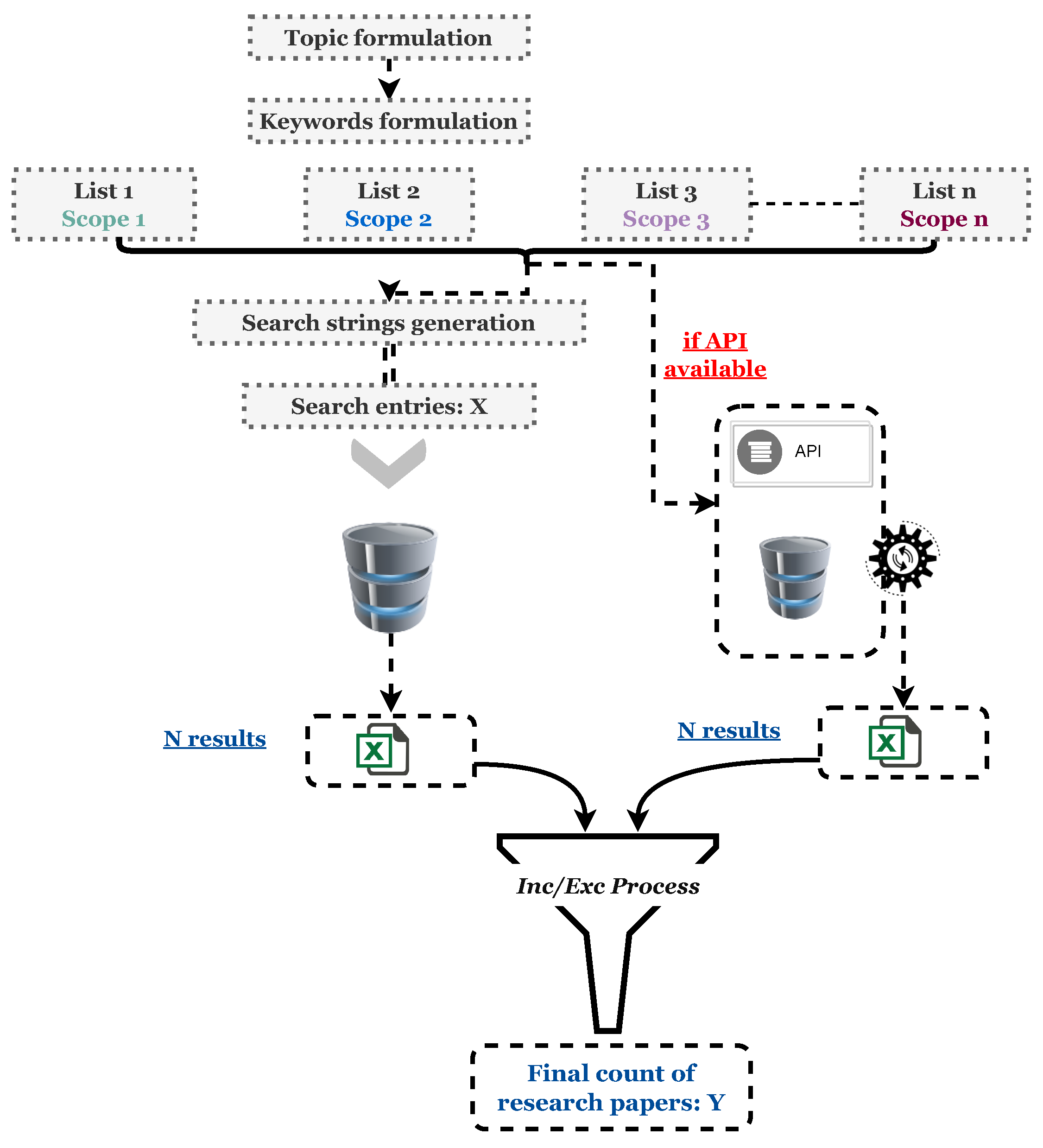
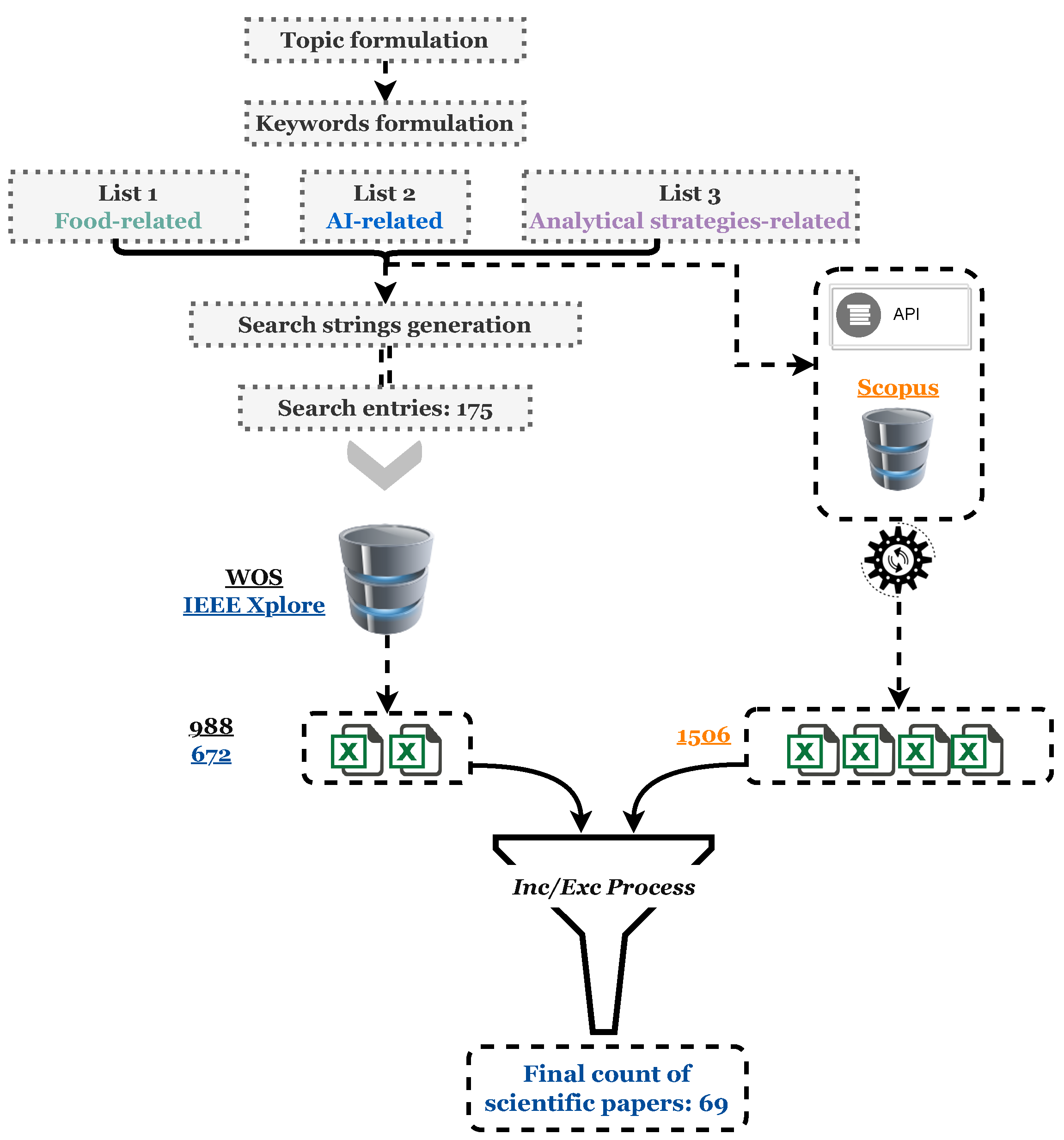

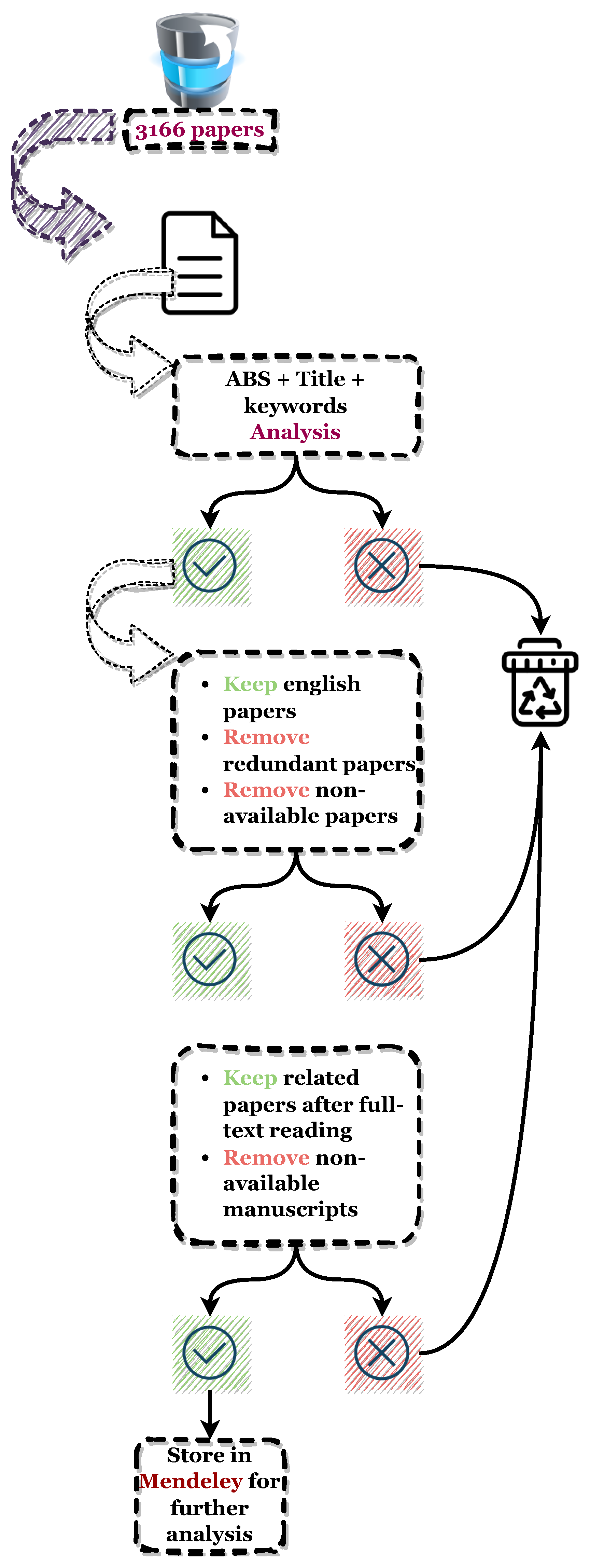
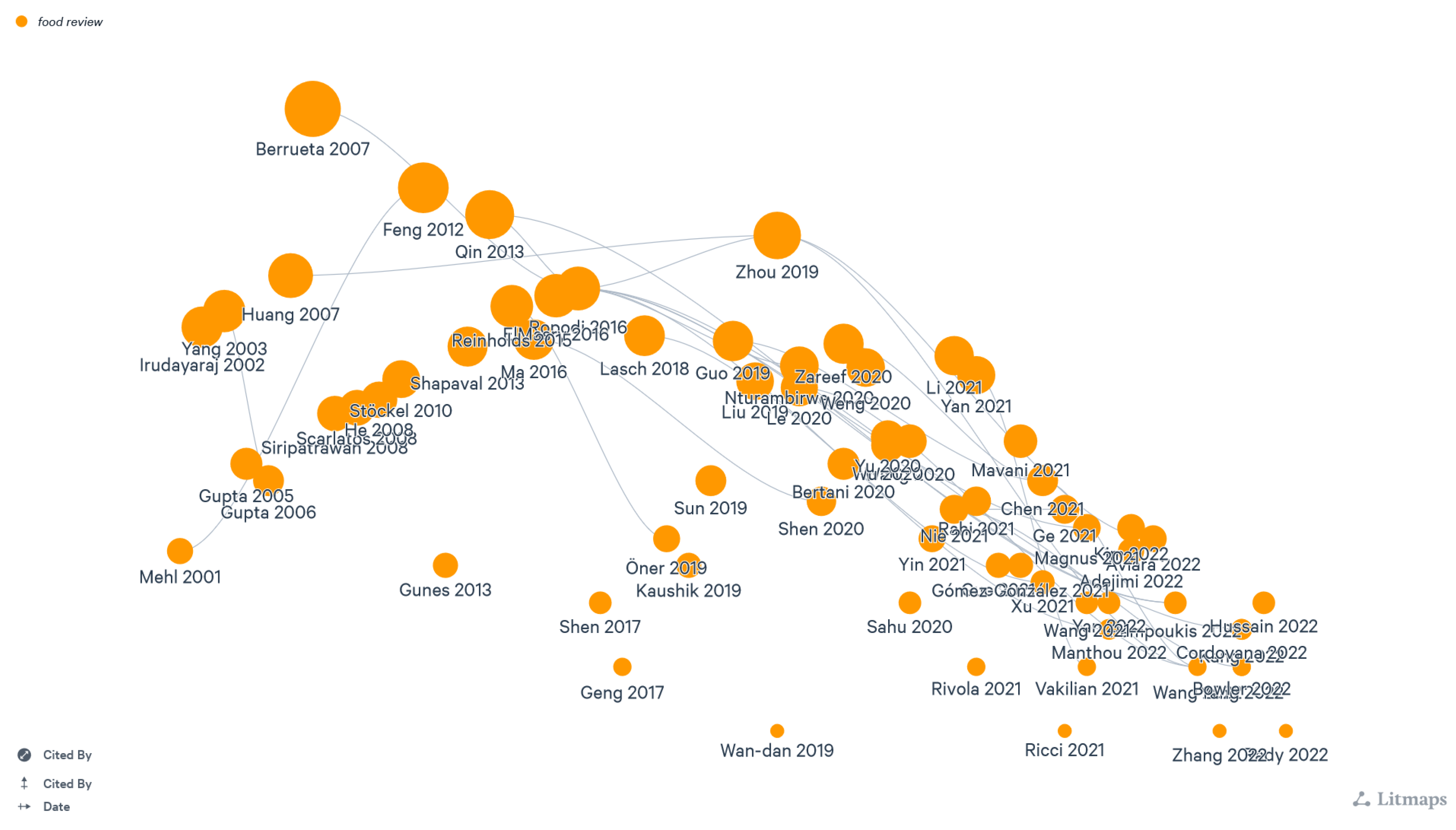
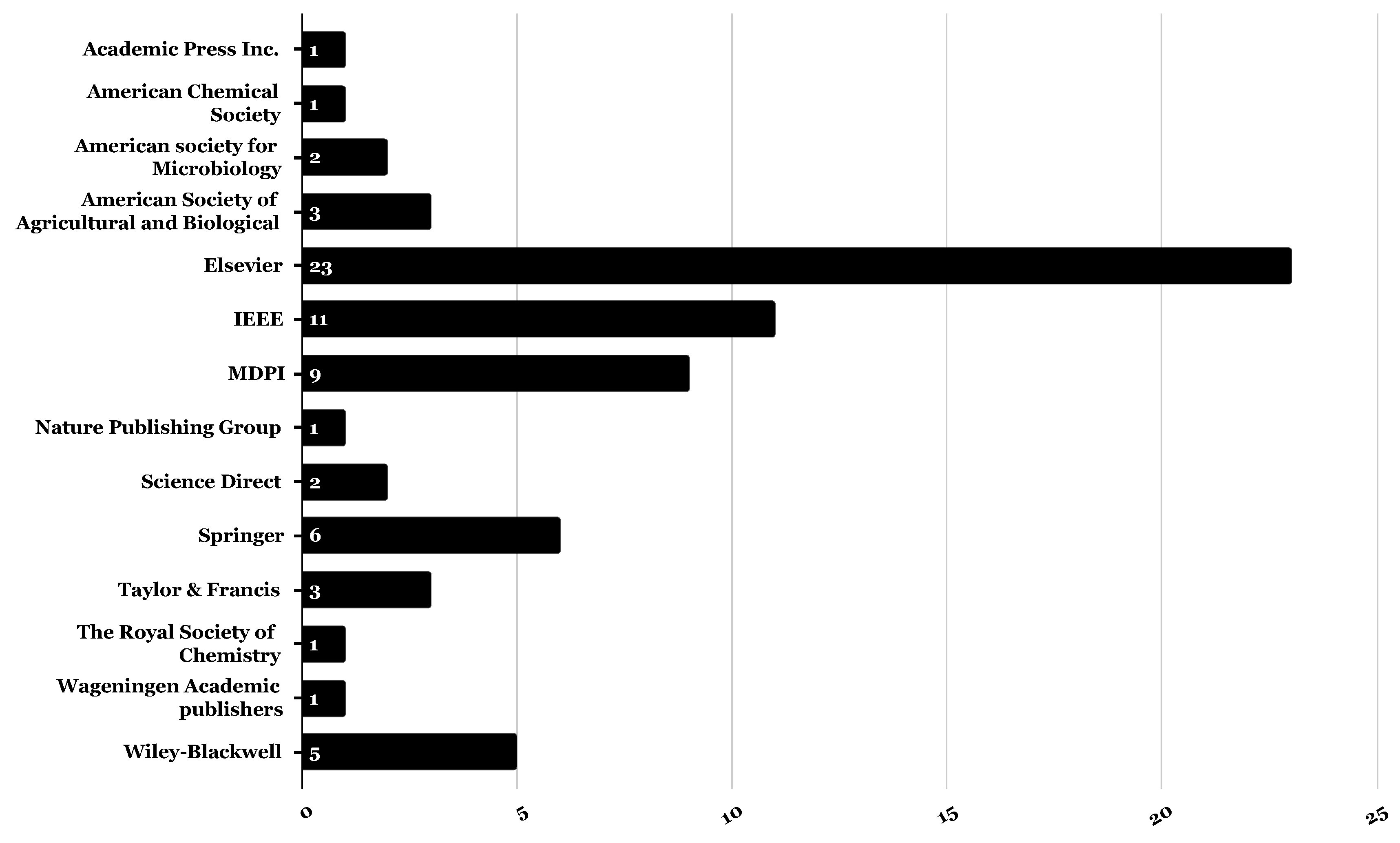
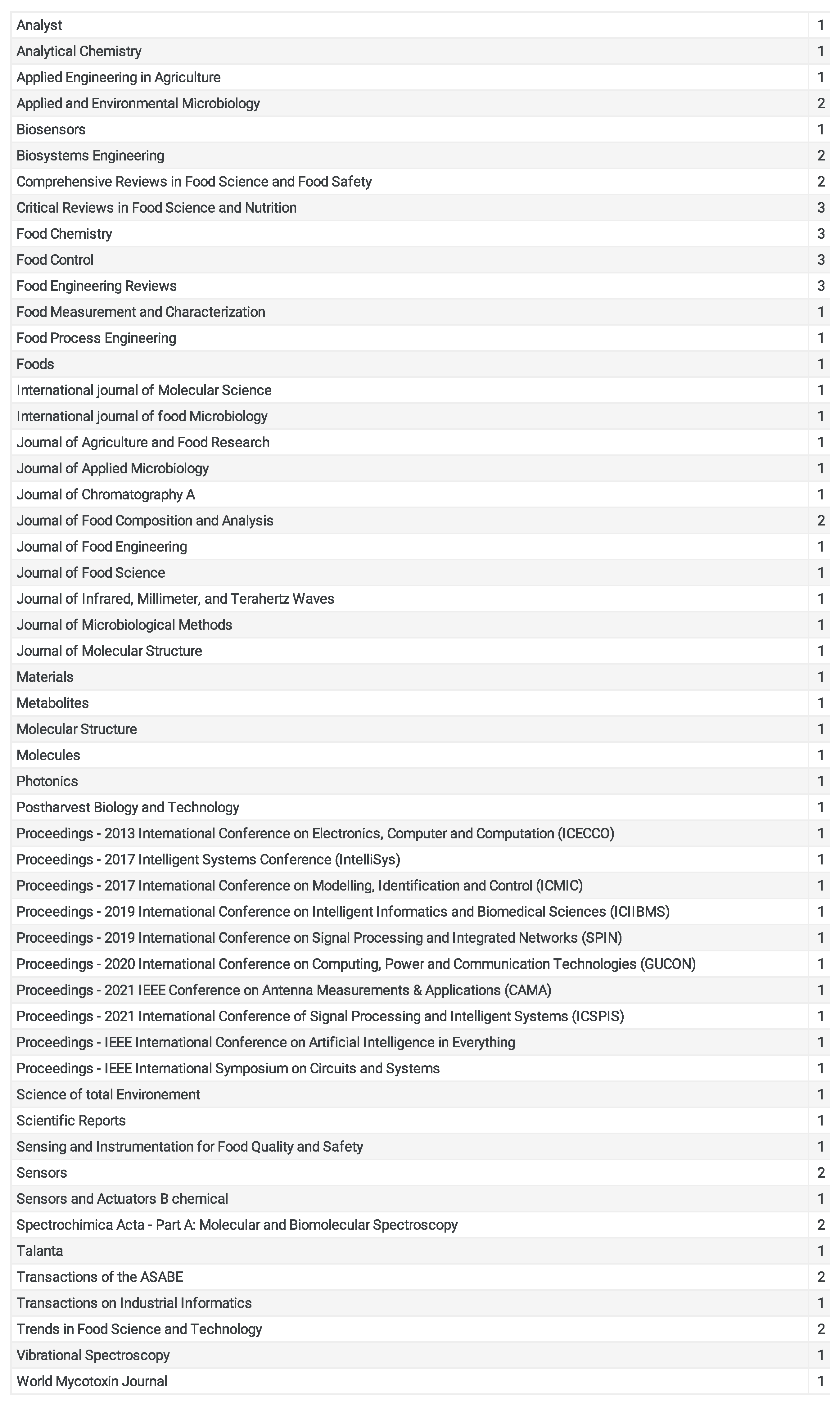
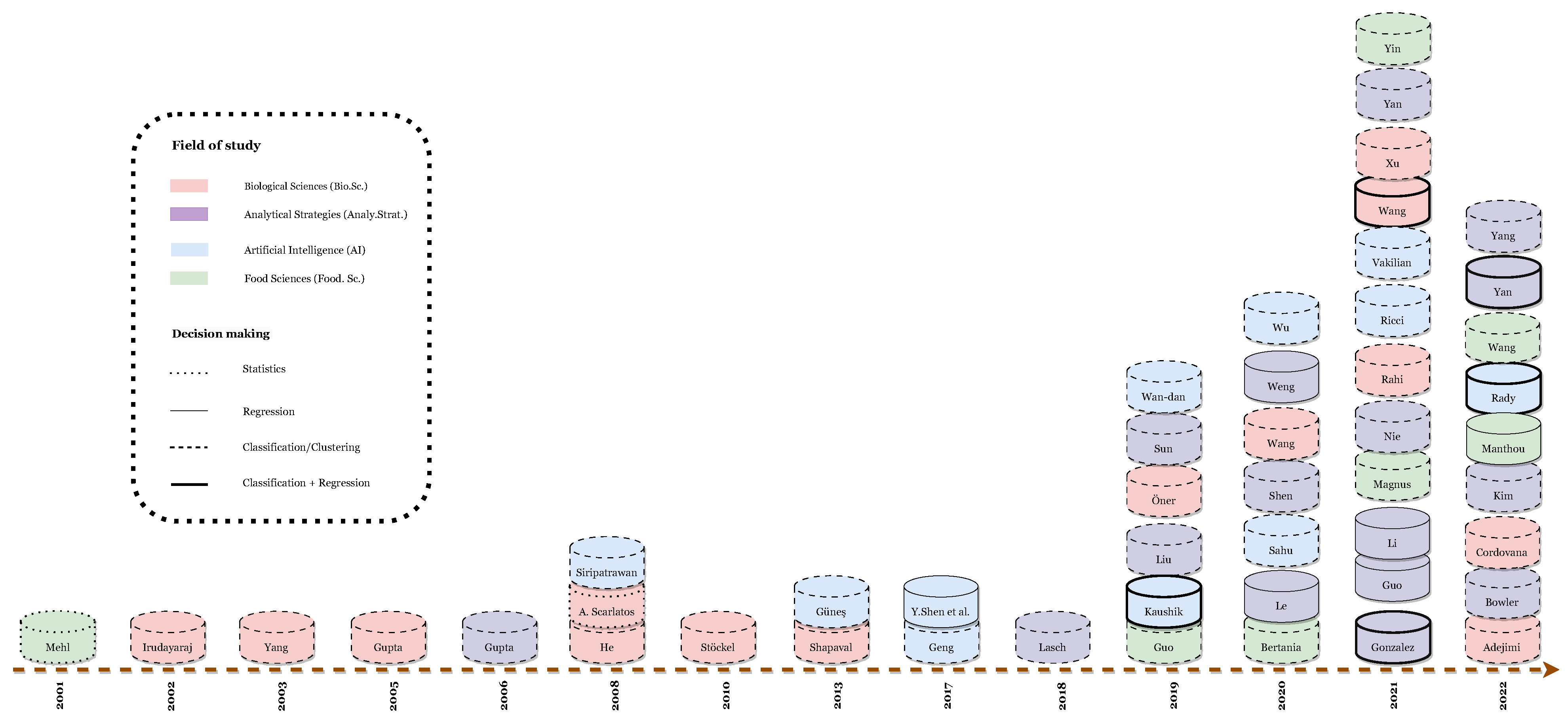



| Analytical Approach | AI Tool | Problematic | Ref. |
|---|---|---|---|
| Spectroscopy | Python-based portable system using Jetson TX2 Module | Food classification of four classes of coffee and purées | [37] |
| Near-infrared spectroscopy | Block sparse Bayesian learning (BSBL) with fast marginalized likelihood maximization (FMLM) | Computational cost reduction for calculating the inverse of a large matrix containing absorption peak information | [38] |
| Impedance spectroscopy | A fuzzy logic model applied on the parameters extracted from distribution of relaxation times (DRT) | Meat-based food classification according to its freshness for different types of muscles | [39] |
| TeraHertz (THz) spectroscopy and chemometrics | Interval partial least squares (iPLS) for optimizing the THz frequency and other preprocessing techniques combined with extreme learning machine (ELM), genetic algorithm support vector machine (GA-SVM), and artificial bee colony algorithm support vector machine (ABC-SVM) for decision making | Three typical soybean origins’ identification | [40] |
| Fourier transform infrared (FTIR) spectroscopy | FTIR and multispectral imaging (MSI) coupled with support vector machines (SVM) for regression | Meat quality assessment, specifically minced pork patties stored under modified atmosphere packaging (MAP) conditions, by estimating the microbial population | [41] |
| Raman spectroscopy | A single convolutional neural network (CNN) model development where hyperparameters, activity functions, and loss functions were optimized | Spectral data preprocessing simplification | [42] |
| Dielectric spectroscopy | Principal component analysis (PCA) for preprocessing and four models, namely support vector machine—SVM, K-nearest neighbor—KNN, linear discriminant—LD and quadratic discriminant—QD, for classification purposes | Discrimination between three citrus juices in order to develop new technologies to identify adulteration | [43] |
| IEEE Xplore | WOS |
|---|---|
| “neural networks” + “spectroscopy” + “food”: 63 | “Machine learning” + “spectroscopy” + “food”: 235 |
| “neural networks” + “chemical analysis” + “food”: 58 | “neural networks” + “spectroscopy” + “food”: 160 |
| “Artificial intelligence” + “chemical analysis” + “food”: 57 | “computer vision” + “spectroscopy” + “food”: 111 |
| “Machine learning” + “spectroscopy” + “food”: 55 | “Deep learning” + “spectroscopy” + “food”: 77 |
| “Artificial intelligence” + “spectroscopy” + “food”: 50 | “Machine learning” + “spectroscopy” + “crop”: 69 |
| “Machine learning” + “chemical analysis” + “food”: 43 | “Artificial intelligence” + “Analytical strategies” + “food”: 37 |
| Title | First Author | Publisher | Type | Year | Ref. |
|---|---|---|---|---|---|
| Detection of defects on selected apple cultivars using hyperspectral and multispectral image analysis | Mehl | ASABE | A | 2001 | [47] |
| Differentiation and detection of microorganisms using Fourier Transform infrared photoacoustic spectroscopy | Irudayaraj | Elsevier | A | 2002 | [48] |
| Rapid detection of foodborne microorganisms on food surface using Fourier transform Raman spectroscopy | Yang | Elsevier | A | 2003 | [49] |
| Differentiation of food pathogens using FTIR and artificial neural networks | Gupta | ASABE | A | 2005 | [50] |
| Identification and quantification of foodborne pathogens in different food matrices using FTIR spectroscopy and artificial neural networks | Gupta | ASABE | A | 2006 | [51] |
| Applications of Artificial Neural Networks (ANNs) in Food Science | Huang | Taylor & Francis | R | 2007 | [52] |
| Supervised pattern recognition in food analysis | Berrueta | Elsevier | R | 2007 | [53] |
| Cortical Networks Grown on Microelectrode Arrays as a Biosensor for Botulinum Toxin | Scarlatos | Wiley-Blackwell | A | 2008 | [54] |
| Detecting single Bacillus spores by surface enhanced Raman spectroscopy | He | Springer | A | 2008 | [55] |
| Self-organizing algorithm for classification of packaged fresh vegetable potentially contaminated with foodborne pathogens | Siripatrawan | Elsevier | A | 2008 | [56] |
| Raman Spectroscopy-Compatible Inactivation Method for Pathogenic Endospores | Stöckel | American society for Microbiology | A | 2010 | [57] |
| Application of Hyperspectral Imaging in Food Safety Inspection and Control: A Review | Feng | Taylor & Francis | R | 2012 | [58] |
| Characterization of food spoilage fungi by FTIR spectroscopy | Shapaval | Wiley-Blackwell | A | 2013 | [59] |
| Detection of aflatoxin contaminated figs using Near-Infrared (NIR) reflectance spectroscopy | Güneş | IEEE | A | 2013 | [60] |
| Hyperspectral and multispectral imaging for evaluating food safety and quality | Qin | Elsevier | R | 2013 | [61] |
| Analytical techniques combined with chemometrics for authentication and determination of contaminants in condiments: A review | Reinholds | Elsevier | R | 2015 | [62] |
| Applications of computer vision for assessing quality of agri-food products: a review of recent research advances | Ma | Taylor & Francis | R | 2016 | [63] |
| Data mining derived from food analyses using non-invasive/non- destructive analytical techniques; determination of food authenticity, quality & safety in tandem with computer science disciplines | Ropodi | Elsevier | R | 2016 | [64] |
| Image analysis operations applied to hyperspectral images for non-invasive sensing of food quality—A comprehensive review | ElMasry | Science Direct | R | 2016 | [65] |
| Early Warning Modeling and Application based on Analytic Hierarchy Process Integrated Extreme Learning Machine | Geng | IEEE | A | 2017 | [66] |
| Feasibility of Non-Destructive Internal Quality Analysis of Pears by Using Near-Infrared Diffuse Reflectance Spectroscopy | Shen | IEEE | A | 2017 | [67] |
| FT-IR Hyperspectral Imaging and Artificial Neural Network Analysis for Rapid Identification of Pathogenic Bacteria | Lasch | American Chemical Society | A | 2018 | [68] |
| An Approach for the Development of a Sensing System to Monitor Contamination in Stored Grain | Kaushik | IEEE | A | 2019 | [69] |
| Application of Deep Learning in Food: A Review | Zhou | Wiley-Blackwell | R | 2019 | [70] |
| Machine learning algorithms for the automated classification of contaminated maize at regulatory limits via infrared attenuated total reflection spectroscopy | Öner | Wageningen Academic publishers | A | 2019 | [71] |
| Quantitative assessment of zearalenone in maize using multivariate algorithms coupled to Raman spectroscopy | Guo | Elsevier | A | 2019 | [72] |
| Raman Spectroscopy Classification of Foodborne Pathogenic Bacteria Based on PCA-Stacking Model | Wan-dan | IEEE | A | 2019 | [73] |
| Rapid determination of aflatoxin B1 concentration in soybean oil using terahertz spectroscopy with chemometric methods | Liu | Elsevier | A | 2019 | [74] |
| Terahertz Spectroscopy Determination of Benzoic Acid Additive in Wheat Flour by Machine Learning | Sun | Springer | A | 2019 | [75] |
| An Overview on the Applications of Typical Non-linear Algorithms Coupled With NIR Spectroscopy in Food Analysis | Zareef | Springer | R | 2020 | [76] |
| Application of deep learning and near infrared spectroscopy in cereal analysis | Le | Elsevier | A | 2020 | [77] |
| Arcobacter Identification and Species Determination Using Raman Spectroscopy Combined with Neural Networks | Wang | American Society for Microbiology | A | 2020 | [78] |
| Deep learning networks for the recognition and quantitation of surface-enhanced Raman Spectroscopy | Weng | The Royal Society of Chemistry | A | 2020 | [79] |
| Development of Machine Learning & Edge IoT Based Non-destructive Food Quality Monitoring System using Raspberry Pi | Sahu | IEEE | A | 2020 | [80] |
| Emerging techniques for determining the quality and safety of tea products: A review | Yu | Wiley-Blackwell | R | 2020 | [81] |
| Machine learning applications to non-destructive defect detection in horticultural products | Nturambirwe | Science Direct | R | 2020 | [82] |
| Multi-view Learning for Subsurface Defect Detection in Composite Products: a Challenge on Thermographic Data Analysis | Wu | IEEE | A | 2020 | [83] |
| On-line prediction of hazardous fungal contamination in stored maize by integrating Vis/NIR spectroscopy and computer vision | Shen | Elsevier | A | 2020 | [84] |
| Optical detection of aflatoxins B in grained almonds using fluorescence spectroscopy and machine learning algorithms | Bertania | Elsevier | A | 2020 | [85] |
| Achieving a robust Vis/NIR model for microbial contamination detection of Persian leek by spectral analysis based on genetic, iPLS algorithms and VIP scores | Rahi | Elsevier | A | 2021 | [86] |
| Application of Artificial Intelligence in Food Industry—a Guideline | Mavani | Springer | R | 2021 | [87] |
| Applications of THz Spectral Imaging in the Detection of Agricultural Products | Ge | MDPI | R | 2021 | [88] |
| Bioimpedance data statistical modelling for food quality classification and prediction | Rivola | IEEE | R | 2021 | [89] |
| Characterisation and Classification of Foodborne Bacteria Using Reflectance FTIR Microscopic Imaging | Xu | MDPI | A | 2021 | [90] |
| Combining optical spectroscopy and machine learning to improve food classification | Magnus | Elsevier | A | 2021 | [91] |
| Deep Learning for Rapid Identification of Microbes Using Metabolomics Profiles | Wang | MDPI | A | 2021 | [92] |
| Hyperspectral image processing for the identification and quantification of lentiviral particles in fluid samples | Gómez-González | Nature Publishing Group | A | 2021 | [93] |
| Identification of the apple spoilage causative fungi and prediction of the spoilage degree using electronic nose | Guo | Wiley-Blackwell | A | 2021 | [94] |
| Investigation of nonlinear relationship of surface enhanced Raman scattering signal for robust prediction of thiabendazole in apple | Li | Elsevier | A | 2021 | [95] |
| Metaheuristic Optimization to Improve Machine Learning in Raman Spectroscopic based Detection of Foodborne Pathogens | Vakilian | IEEE | A | 2021 | [96] |
| Microwave Sensing for Food Safety: a Neural Network Implementation | Ricci | IEEE | A | 2021 | [97] |
| Non-destructive detection of foreign contaminants in toast bread with near infrared spectroscopy and computer vision techniques | Yin | Springer | A | 2021 | [98] |
| Raman spectroscopy combined with machine learning for rapid detection of food-borne pathogens at the single-cell level | Yan | Elsevier | A | 2021 | [99] |
| Recent advances in assessing qualitative and quantitative aspects of cereals using nondestructive techniques: A review | Zareef | Elsevier | R | 2021 | [100] |
| Trace Identification and Visualization of Multiple Benzimidazole Pesticide Residues on Toona sinensis Leaves Using Terahertz Imaging Combined with Deep Learning | Nie | MDPI | A | 2021 | [101] |
| A Novel Method for Carbendazim High-Sensitivity Detection Based on the Combination of Metamaterial Sensor and Machine Learning | Yang | MDPI | A | 2022 | [102] |
| Advances in Machine Learning and Hyperspectral Imaging in the Food Supply Chain | Kang | Springer | R | 2022 | [103] |
| Component spectra extraction and quantitative analysis for preservative mixtures by combining terahertz spectroscopy and machine learning | Yan | Elsevier | A | 2022 | [104] |
| Design of Food Safety Supervision System in the Background of Big Data | Zhang | IEEE | R | 2022 | [105] |
| Detection and quantification of peanut contamination in garlic powder using NIR sensors and machine learning | Rady | Academic Press Inc. | A | 2022 | [106] |
| Domain Adaptation for In-Line Allergen Classification of Agri-Food Powders Using Near-Infrared Spectroscopy | Bowler | MDPI | A | 2022 | [107] |
| Investigation of reflectance, fluorescence, and Raman hyperspectral imaging techniques for rapid detection of aflatoxins in ground maize | Kim | Elsevier | A | 2022 | [108] |
| Low-Resolution Raman Spectroscopy for the detection of contaminant species in algal bioreactors | Adejimi | Elsevier | A | 2022 | [109] |
| Machine learning-based typing of Salmonella enterica O-serogroups by the Fourier-Transform Infrared (FTIR) Spectroscopy-based IR Biotyper system | Cordovana | Elsevier | A | 2022 | [110] |
| Markov Transition Field Combined with Convolutional Neural Network Improved the Predictive Performance of Near-Infrared Spectroscopy Models for Determination of Aflatoxin B1 in Maize | Wang | MDPI | A | 2022 | [111] |
| Potential application of hyperspectral imaging in food grain quality inspection, evaluation and control during bulk storage | Aviara | Elsevier | R | 2022 | [112] |
| Recent Advances and Applications of Rapid Microbial Assessment from a Food Safety Perspective | Pampoukis | MDPI | R | 2022 | [113] |
| Recent Progress in Spectroscopic Methods for the Detection of Foodborne Pathogenic Bacteria | Hussain | MDPI | R | 2022 | [114] |
| Spectroscopy and imaging technologies coupled with machine learning for the assessment of the microbiological spoilage associated to ready-to-eat leafy vegetables | Manthou | Elsevier | A | 2022 | [115] |
| Ref. | Crop-Food | Preprocessing Steps | Decision Model |
|---|---|---|---|
| [81] | Tea | Standard normal variate (SNV) and multiplicative scatter corrections | PCA, KNN, KPCA, ANN, HCA, BPNN, PLS, CPNN, SPA, PNN, ELM, LDA, SVM, S-LDA, LVQ, KLDA, MLP, RBF, RF |
| [103] | Apple, wolfberry, lettuce, pear, green plum, peach, strawberry, Brassica, jujube, lettuce and chives | LLE, LE, ISOMAP and MDS, SNE and t-SNE | PLSR, KNN, LDA, NB, DT, SVR, SVM, RF, LSSVM, LWR, FNN, ResNet, CNN, and DNN |
| [76] | Grain products, forages, oil, fruits, vegetables, sugarcane seeds, coffee, tea, spices, black/green tea, grapes, apples, wheat flour, rice and barley | Multivariate calibration of spectral data, standard normal variate transformation (SNV), multiplicative scatter correction (MSC), smoothing, derivative, wavelet transforms (WT), and orthogonal signal correction (OSC) | ANN, BP-ANN, GA-ANN, RBFNN, AdaBoost, SVM, LA, ELM, SLFN, LS-SVR, SVM, linear, radial basis function (RBF), normalized polynomial, sigmoid, Gaussian RBF, and string kernels |
| [62] | Condiments, spices, and herbs | PCA, HCA, parallel factor analysis (PARAFAC), MPLS, PLS, ANOVA, t-test, straight line subtraction (SLS), constant offset elimination (COE), and minimum–maximum normalization (MMN) | ANN, kNN, PLS regression, PLS-DA, HCA, PCA, LDA, k-means cluster analysis (KM-CA), and DA |
| [87] | Fruits | computer vision systems | Adaptive Neuro Fuzzy Inference System (ANFIS) |
| [70] | Vegetables | CNN | ResNet-152, AlexNet-SVM classifier, and hybrid CNN-SSAE |
| [58] | Apples, cucumbers, spinach, and wheat | PCA, PLSR | PLSDA, ANN, LD, and PCA |
Disclaimer/Publisher’s Note: The statements, opinions and data contained in all publications are solely those of the individual author(s) and contributor(s) and not of MDPI and/or the editor(s). MDPI and/or the editor(s) disclaim responsibility for any injury to people or property resulting from any ideas, methods, instructions or products referred to in the content. |
© 2023 by the authors. Licensee MDPI, Basel, Switzerland. This article is an open access article distributed under the terms and conditions of the Creative Commons Attribution (CC BY) license (https://creativecommons.org/licenses/by/4.0/).
Share and Cite
Raki, H.; Aalaila, Y.; Taktour, A.; Peluffo-Ordóñez, D.H. Combining AI Tools with Non-Destructive Technologies for Crop-Based Food Safety: A Comprehensive Review. Foods 2024, 13, 11. https://doi.org/10.3390/foods13010011
Raki H, Aalaila Y, Taktour A, Peluffo-Ordóñez DH. Combining AI Tools with Non-Destructive Technologies for Crop-Based Food Safety: A Comprehensive Review. Foods. 2024; 13(1):11. https://doi.org/10.3390/foods13010011
Chicago/Turabian StyleRaki, Hind, Yahya Aalaila, Ayoub Taktour, and Diego H. Peluffo-Ordóñez. 2024. "Combining AI Tools with Non-Destructive Technologies for Crop-Based Food Safety: A Comprehensive Review" Foods 13, no. 1: 11. https://doi.org/10.3390/foods13010011
APA StyleRaki, H., Aalaila, Y., Taktour, A., & Peluffo-Ordóñez, D. H. (2024). Combining AI Tools with Non-Destructive Technologies for Crop-Based Food Safety: A Comprehensive Review. Foods, 13(1), 11. https://doi.org/10.3390/foods13010011







